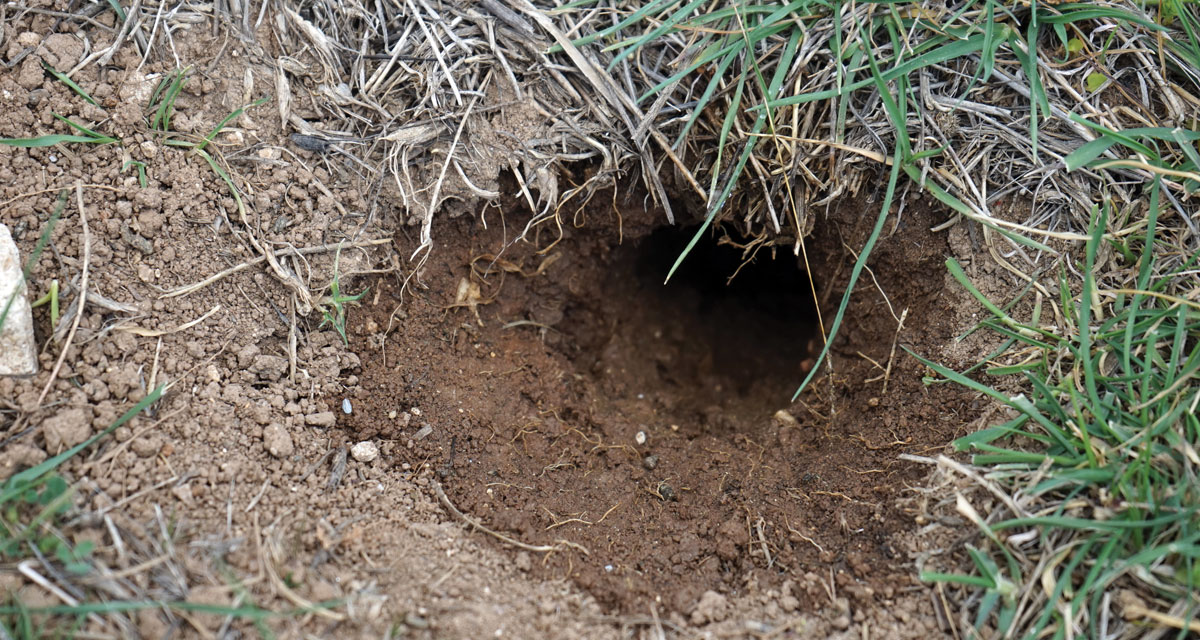A life underground in the darkness and encased, perhaps, by tunnels, is not typically given a thought by those of us dwelling above. Until a sign appears of the inhabitant on the surface, such as a perfectly round hole. Curiosity drives an individual to wonder, what may be living below? Rather than sticking a hand inside the depths, observe from a distance, first. The size of the hole is one indication of what lives within it. Burrowing underground not only provides safety but a shelter against hot or frozen temperatures.
Here is a short list of animals burrowing near you:
Ants: The hole of an ant is easy to recognize. Tall cone-shaped mounds serve as the entrance. In addition to the super ability to lift 20-times its body weight, it leaves a pheromone trail when foraging to show where it has been and how to return home. Attracted to moisture, ants also build nests in building materials, stacks of wood, or burrow through cracks in tree branches.
Bees and Wasps: At least two species of bees and 14,000 species of wasps burrow into the ground. The queen selects the location, typically an already formed hole, and the workers construct the nest. Although some bees and wasps are dangerous stinging pests to humans, they prey mostly on garden insects while assisting the pollination process.
Earthworms:Without jaws, teeth, and eyes, the elongated earthworm crawls forward and backward, swallowing soil, sand, and small stones, and gaining its nutrients through these contents. As it squirms through the soil, the earthworm creates burrows in safe regions, such as under large stones. Finding an earthworm indicates the soil is both healthy and full of nutrients.
Foxes: Not all foxes dig their burrows; frequently, they will take over an established den, which may be near the base of trees or walls. One indication of a fox hole is that the entrance may have evidence of its prey, such as numerous bones or bird feathers. Be wary, because the narrowed four-inch hole can result in injury to a horse or people from a trip or a fall. Additionally, foxes lead to an infestation of various parasites.
Groundhogs: A 10- to 12-inch-diameter hole located near trees, walls, or fences would satisfy a groundhog. Unless raising their young, most groundhogs live alone and try to outsmart their prey. Watching an entrance may not be helpful; groundhogs will have up to four additional access points, which tunnel four feet underground to a sizeable den. Tubing and wires may be damaged if they interfere with the groundhog’s ambition to create a tunnel.
Rats: A smooth entrance, roughly four inches in diameter, is for a small animal, who comes and goes often. While the hole is the same size as that of voles, moles, and deer mice, the rat burrows 18-inches under foundations; yet, the nest can expand to three feet in length. They especially enjoy creating a den under rocks, concrete slabs, or other heavy objects—not just for safety purposes, but to be closer to a significant food source, such as a dumpster or trash cans. Cleverly, rat’s have escape holes in thick ground vegetation like English ivy or under dense hedges.
Rabbits: Surrounded by a mound of dirt, the rabbit hole can extend 10 feet below ground, and be comprised of elaborate tunnels leading to chambers that may span 150 feet. The warren is a habitat for rabbits in woods or forests, meadows and grasslands, wetlands or deserts. Rabbits leave their burrows at night to seek food and return by morning. A wide range of vision aids rabbits to escape capture from a lengthy list of predators.
Skunks: A shallow hole could be from a skunk’s nose, since it digs to extract grubs and worms. (Additional favorite foods are berries, grasshoppers, wasps, beetles, small rodents, and mice.) Despite possessing strong forefeet and long claws, they cannot climb a fence. A skunk will not travel further than two miles distant from a water source or its burrow.
While it may feel intrusive to find a creature which has disrupted large areas of grass, or a beloved garden, burrowing animals and insects have a purpose in our environment. In learning more about the underground dwellers, we can determine if it’s worthwhile to eradicate the animal or allow it to follow its instincts.























